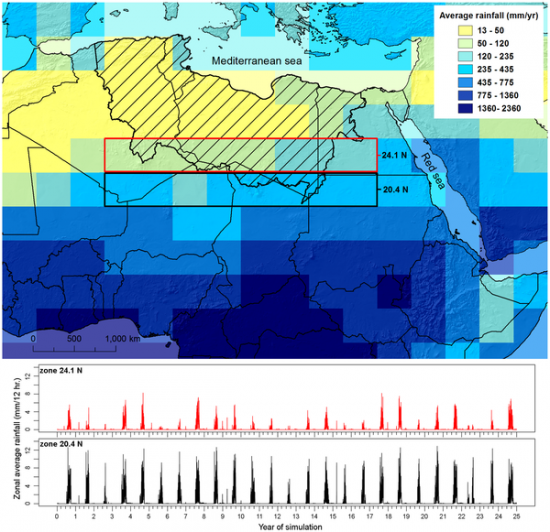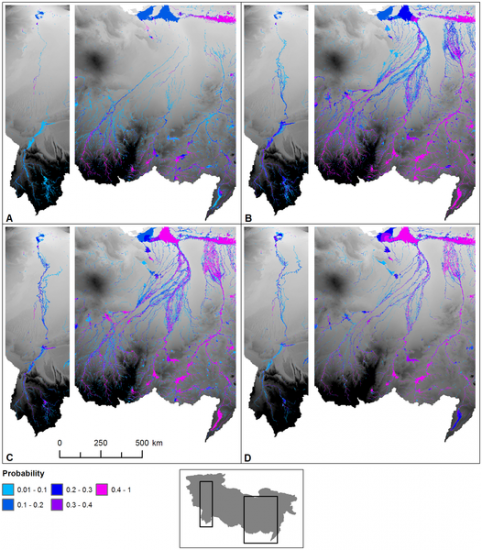Public Library of Science
Source - http://www.eurekalert.org/pub_releases/2013-09/plos-pas090613.php
Paleoclimate simulations reveal potential 'green corridors' across North Africa
Three ancient river systems, now buried, may have created viable routes for human migration across the Sahara to the Mediterranean region about 100,000 years ago, according to research published September 11 in the open access journal PLOS ONE by Tom Coulthard from the University of Hull, UK, and colleagues from other institutions.
Simulating paleoclimates in the region, the researchers found quantitative evidence of three major river systems that likely existed in North Africa 130,000-100,000 years ago, but are now largely buried by dune systems in the desert. When flowing, these rivers likely provided fertile habitats for animals and vegetation, creating 'green corridors' across the region. At least one river system is estimated to have been 100 km wide and largely perennial. The Irharhar river, westernmost of the three identified, may represent a likely route of human migration across the region. In addition to rivers, the researchers' simulations predict massive lagoons and wetlands in northeast Libya, some of which span over 70,000-square kilometers. "It's exciting to think that 100 000 years ago there were three huge rivers forcing their way across a 1000km of the Sahara desert to the Mediterranean -- and that our ancestors could have walked alongside them" said Coulthard.
Previous studies have shown that people travelled across the Saharan mountains toward more fertile Mediterranean regions, but when, where and how they did so is a subject of debate. Existing evidence supports the possibilities of a single trans-Saharan migration, many migrations along one route, or multiple migrations along several different routes. The existence of 'green corridors' that provided water and food resources were likely critical to these events, but their location and the amount of water they carried is not known. The simulations provided in this study aim to quantify the probability that these routes may have been viable for human migration across the region.
###
Citation: Coulthard TJ, Ramirez JA, Barton N, Rogerson M, Brücher T (2013) Were Rivers Flowing across the Sahara During the Last Interglacial? Implications for Human Migration through Africa. PLoS ONE 8(9): e74834. doi:10.1371/journal.pone.0074834

Figure 1. Palaeorainfall used to drive the combined numerical model.
Yearly average rainfall from a 25 year snapshot of an ESM experiment and catchment area (hatched region) as well as the time series of zonally averaged precipitation for two stripes south of the catchment highlighting the (i) South-North gradient of rainfall during the wet seasons (June to September) and (ii) the modelled year to year variability of the monsoon system. The data is drawn from 12 hourly precipitation data produced during a time-slice experiment [27] of the last Interglacial (MIS 5e, ~124 ka BP) performed by the fully coupled atmosphere-ocean- sea ice-biosphere general circulation model of the Max-Planck-Institute for Meteorology. The ESM consists of the spectral atmosphere model ECHAM5 [43] including the land surface model JSBACH [44] and a dynamic vegetation module [65] coupled to the general circulation ocean model MPIOM [45]. The model runs for the atmosphere at a truncation T31, which corresponds to a horizontal resolution of ~300 km in the area under investigation. doi:10.1371/journal.pone.0074834.g001

Figure 2. Simulated probability of surface water during the last interglacial.
This figure details Archaeological sites, and an annual probability that a location has surface water. The archaeological data are derived from a number of sources (including [42], [66], [67], [68]. The findspots are characterised by Aterian and Middle Stone Age artefacts such as bifacial foliates and stemmed Aterian points and/or typical ‘Mousterian’ points, side scrapers and Levallois technology. Most are represented by surface scatters but where stratified examples exist these can be shown by dating (OSL and U-series techniques) and geomorphological setting to belong within MIS 5e [41], [42]. doi:10.1371/journal.pone.0074834.g002

Figure 3. Seasonal flow of surface water across the Sahara during the last interglacial.
Monthly probability of surface water being present for (a) August, (b) September, (c) October and (d) November. These illustrate the hydrodynamics of the system simulated by the large scale 2d hydraulic model that routes a flood wave of water north across the desert from the mountains.
doi:10.1371/journal.pone.0074834.g003